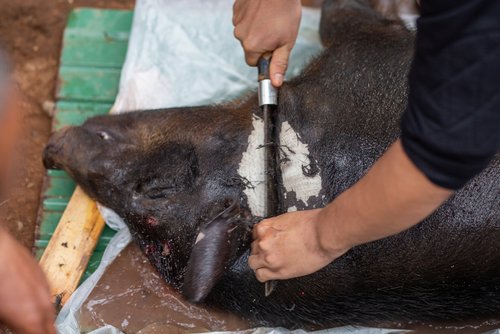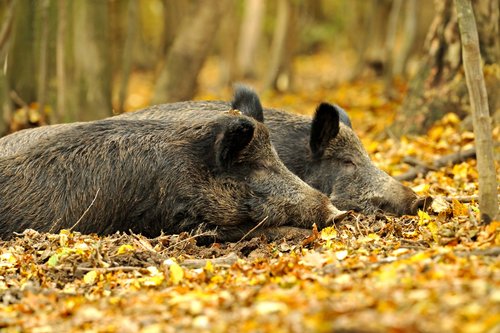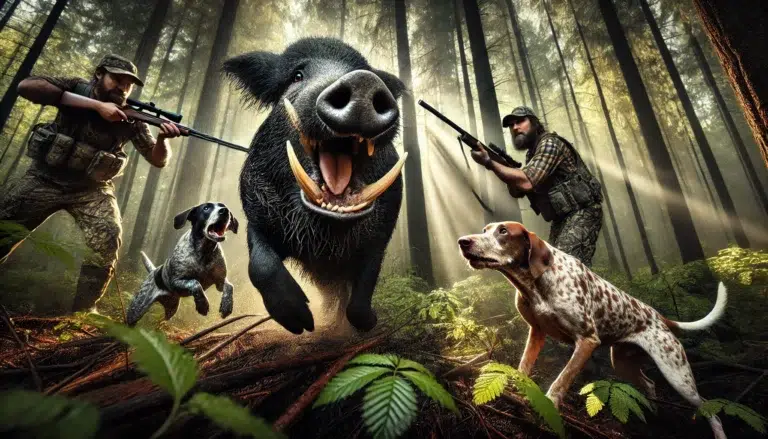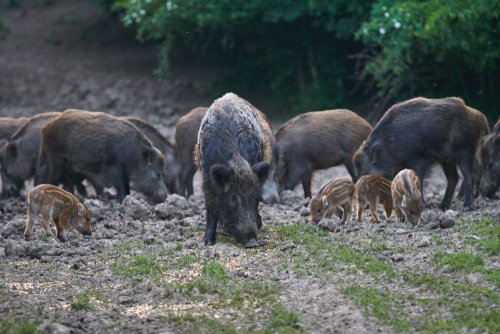Hog Field Dressing: The First Step to Quality Meat
Hog field dressing is an essential skill that every hog hunter should possess. It is not only crucial for preserving the meat’s quality but also for ensuring food safety.
When it comes to field-dressing hogs, having the right tools and equipment is paramount. You’ll need strong and sharp knives suitable for cutting through tough hide and thick muscle fibers.
A bone saw or cleaver can also be useful for larger hogs. Additionally, having some heavy-duty gloves will protect your hands from cuts and ensure better grip while handling slippery entrails.
Now that you have all your gear ready let’s dive into the step-by-step process of field dressing a hog. Remember to approach this task cautiously and respect the animal and yourself.
First, position the hog properly by laying it on its back with its legs facing upward. This will make access to its underbelly much easier.
Then, start by making an incision along its belly from just below its ribcage towards its hindquarters using a sharp knife or razor blade. Slowly cut through the skin, taking care not to puncture any organs underneath until you reach the sternum area near the chest cavity.
At this point, you’ll need to exercise caution as you navigate around vital organs such as the lungs and heart. Once you’ve made an incision, it’s time to remove the hog’s internal organs.
Start by cutting around the anus area to detach the rectum. Be sure to tie it off or clamp it shut with a rubber band or zip tie to prevent contamination.
Carefully work your way up, slicing through connective tissues and membranes that hold the organs in place. This process requires steady hands and precision, as you want to avoid puncturing any of the organs.
Remove the entrails individually, being mindful of their placement and avoiding contact with edible meat. As you’re working through this process, remember that safety should always be a top priority.
Wearing protective gear like gloves and eye goggles will minimize hazards from sharp objects or bodily fluids. Field dressing hogs are vital in processing harvested game and obtaining high-quality meat.
With the right tools, techniques, and safety precautions, you can always ensure a successful field dressing experience. So, next time you find yourself on an exhilarating hog-hunting adventure, take pride in your ability to honor nature by skillfully butchering hogs in the field.
Tools and Equipment for Hog Field Dressing
When it comes to tackling the task of hog field dressing, having the right tools and equipment is paramount. Without the necessary gear, you wouldn’t want to be in a sticky situation. So, let’s take a closer look at what you’ll need to process those beautifully harvested hogs successfully.
First and foremost, you’ll require a good quality hunting knife. Sharp and sturdy, this trusty tool will be your best friend throughout the field dressing process.
Look for a blade around 4-6 inches long with a strong handle for easy grip. A knife with a gut hook can also be useful when opening up the hog.
Apart from your faithful knife, you’ll need a bone saw or hacksaw with sharp teeth. This will help you efficiently cut through bones when separating various parts of the hog during butchering.
Ensure the saw is durable and has replaceable blades to withstand the demands of processing harvested hogs over time. Another essential tool for hog field dressing is a pair of heavy-duty gloves.
Not only do these protect your hands from potential cuts and scrapes, but they also provide a better grip when handling slippery entrails or slippery situations! Opt for gloves made from rubber or latex that offer dexterity and protection.
Additionally, having a solid game bag or backpack specifically designed for hunting is crucial to keep your tools organized and easily accessible during field dressing. Look for one with multiple compartments to neatly store knives, saws, gloves, and other small accessories like zip ties or disposable bags.
So there you have it – four key tools and equipment essential to successful hog field dressing: a reliable hunting knife, a bone saw or hacksaw, heavy-duty gloves, and an efficient game bag or backpack to keep everything organized. Armed with these essentials, you’ll be well-prepared to tackle the challenges of processing harvested hogs and enjoy the fruits of your labor during butchering.
Step-by-Step Guide to Hog Field Dressing
Now that you have successfully hunted down a hog, it’s time to tackle the next crucial step – field dressing. This process is essential to ensure the meat’s quality and minimize potential risks.
Follow this step-by-step guide to hog field dressing, and you’ll be well on your way to a delicious feast. First things first, make sure you have all the necessary tools at hand.
You’ll need a sharp knife or a dedicated field dressing kit, latex gloves for hygiene purposes, and a sturdy rope or gambrel to hang the hog. Keep some clean water and paper towels nearby to rinse your hands and wipe off excess blood.
Start by securing the hog with the rope or gambrel upright. This will make accessing different areas of the animal’s body easier while field dressing it.
Make sure it is properly secured before proceeding further. Begin with an incision along the belly from just below the chest bone to the pelvis.
Take caution not to puncture any organs during this process as it may contaminate the meat once you’ve made this initial incision, carefully cut through the connective tissues around its anus.
Next, gently reach inside with your gloved hand and gradually loosen or cut away any attachments between its innards and abdominal wall using your knife. Be cautious while doing this, as various organs are handlines, bladder, and reproductive organs.
Move slowly and de, need careful handlingliberately, paying attention not to rupture any of these organs as it may spoil your efforts toward obtaining quality meat. Once you’ve loosened all connections between internal organs and their surrounding structures, carefully remove them from inside the hog’s body cavity one by one.
As you proceed with this delicate task, remember not to sever any bile ducts or introduce fecal matter onto the meat. Take your time and work with precision, ensuring a clean and thorough job.
That concludes the step-by-step guide to hog field dressing. Remember, this process is vital to ensure the meat quality you’ll process and butcher later.
Take your time, be meticulous, and exercise caution throughout the procedure. Happy hunting!
From Field to Table: Hog Butchering Basics
Once you’ve successfully field-dressed your hog, it’s time to take that beast from the field to the table. This is where the real magic happens – transforming a wild animal into succulent cuts of meat that will have your taste buds dancing with delight. But before we dive into the nitty-gritty of hog butchering, let’s talk about some basics you need to know.
First things first, make sure you have a clean and organized workspace. This is crucial for maintaining hygiene and ensuring a quality end product.
Find a sturdy table or workbench that is easy to clean and sanitize. Lay down plastic sheets or butcher paper to catch any mess and make cleanup a breeze.
Next, gather your essential tools for butchering hogs. For various cutting tasks, you’ll need a set of sharp knives, preferably with different blade lengths.
A boning knife is perfect for precise cuts around bones, while a larger butcher knife can handle bigger meat sections. Don’t forget to have some heavy-duty kitchen shears handy for trimming fat and separating joints.
Now that we’re all set up, it’s time to dive into the actual butchering process. Start by removing the skin from the hog using long, deliberate strokes with your knife.
Take care not to pierce too deeply into the fat layer beneath, as this can affect the taste and texture of the meat. Once you’ve removed the skin, it’s time to break down the hog into manageable sections.
Begin by locating major joints like shoulders and hams, and use your butcher knife or saw to separate them from the carcass. Depending on your preferred cooking methods, You can move on to smaller cuts like ribs or loins.
As you process harvested hogs into cuts of meat, remember that each section has unique flavors and textures when cooked properly. The shoulder offers rich marbling and tender meat, ideal for slow roasting or smoking, while the ham is perfect for curing and turning into mouthwatering hams.
Conversely, the ribs are a barbecue enthusiast’s dream when slathered in a tangy sauce and grilled to perfection. Butchering hogs is an art that takes time and practice to master.
Don’t be discouraged if you don’t get it right the first time – it’s all part of the learning process. With each hog you process, your skills will improve, and soon enough, you’ll be impressing your friends and family with delicious cuts of meat that came straight from your own hands.
So, roll up your sleeves, sharpen those knives, and embark on a journey into hog butchering—nothing quite like enjoying a meal made from scratch – from field to table.
Hog Butchering Techniques and Tips
Hog butchering is an art that requires skill, precision, and a deep understanding of the animal’s anatomy. This section will delve into some hog butchering techniques and share tips to ensure you get the most out of your harvest.
One important technique to master is the proper use of a boning knife. When it comes to butchering hogs, having a sharp and sturdy boning knife is crucial.
This specialized tool allows you to separate the meat from the bones easily. Start by making small incisions along the joints and connective tissues, then carefully work your way through, separating the different cuts of meat.
Another technique that can greatly enhance your hog butchering skills is “seam butchery.” Seam butchery involves following natural seams in the animal’s muscle structure to create clean and precise cuts. By doing so, you maximize the yield of each cut and ensure that no delicious morsel goes to waste.
Seem butchery can be a game-changer, whether separating pork chops from the loin or deboning shoulder roasts. When it comes to tips for hog butchering, one piece of advice is to keep your cutting area clean and organized.
Proper sanitation ensures food safety and helps maintain efficiency during the process. Having a designated area for different cuts of meat will allow you to work smoothly without any confusion or cross-contamination.
Additionally, don’t be afraid to get creative with your cuts! While traditional cuts like ribs and bacon are popular choices (and for good reason), lesser-known cuts can be just as delectable if prepared correctly.
For instance, jowl bacon—an often overlooked cut derived from the cheek—can rival its belly counterpart in terms of flavor and tenderness when cured and smoked. Mastering hog butcher techniques takes time and practice.
With a sharp boning knife, an understanding of seam butchery, a clean working area, and a willingness to experiment with cuts, you’ll be well on your way to processing harvested hogs like a seasoned pro. So sharpen your knives and prepare for a satisfying culinary adventure that will honor the animal you’ve harvested.
Processing Harvested Hogs for Quality Meat
Now that you have successfully field-dressed and butchered your hog, it’s time to take the next step towards ensuring the highest quality meat possible. Processing harvested hogs involves a series of steps that will transform the animal into various cuts of meat suitable for cooking and storing.
Let’s dive into some key aspects of this process. Firstly, after butchering, it is essential to thoroughly clean and rinse all the meat.
Use cold water to wash away any dirt or debris that may have come into contact with the animal during field dressing. This step helps maintain hygiene and removes any lingering gamey flavors from the hog.
Once cleaned, it’s time to divide the meat into different cuts. This includes separating shoulders, ribs, loins, and hams.
You can utilize a sharp boning knife or a handsaw to make precise cuts along natural muscle lines. Remember, each cut has a unique cooking purpose and should be treated accordingly.
After cutting up the hog, you can further process some portions into ground meat or sausages. Grinding allows you to create versatile options like ground pork for burgers or sausages with custom flavors by adding spices such as garlic or sage.
Invest in a sturdy grinder attachment for your kitchen mixer or a manual grinder if you prefer an arm workout! To maximize storage life and minimize potential spoilage risks, consider vacuum sealing individual portions of meat before freezing them.
Vacuum sealing removes excess air around the meat, reducing freezer burn and maintaining freshness over extended periods. Label each package with details like date and cut type for easy identification later.
By meticulously processing harvested hogs through cleaning, cutting into desired portions, grinding when needed, and vacuum sealing before freezing, you can ensure that your hard-earned game will yield succulent results throughout many delightful meals. Remember, processing harvested hogs requires attention to detail and adherence to proper hygiene practices.
By investing time and effort in this essential step, you’ll be rewarded with the satisfaction of knowing you’ve done everything possible to deliver the highest quality meat to your table. So roll up your sleeves, sharpen those knives, and let the art of butchering hogs unfold!
Safety Measures During Field Dressing and Butchering
Safety should always be your top priority when it comes to hog field dressing and butchering.
The process involves sharp knives, heavy equipment, and potentially dangerous situations. Taking the necessary safety precautions can minimize the risk of accidents and ensure a smooth and incident-free experience.
First and foremost, before you even start the field dressing process, make sure you are properly equipped with the right tools. A sturdy pair of gloves is essential to protect your hands from potential cuts or exposure to bacteria.
Additionally, wearing protective eyewear will shield your eyes from debris that may fly around during butchering. It’s also crucial to maintain a clean work area.
Before beginning any processing or butchering tasks, thoroughly wash all surfaces with hot, soapy water or disinfectant solution. This will help eliminate contaminants that could spoil the meat or pose a health risk.
Remember that cleanliness should be maintained throughout the field dressing process. Another important safety measure is the proper use of cutting tools.
Ensure your knives are sharp and well-maintained to prevent slipping or accidental injuries caused by applying too much force. When using larger equipment like saws or cleavers for hog butchering, exercise caution and follow manufacturer instructions for safe usage.
Practicing good personal hygiene is vital during hog field dressing and butchering activities. Wash your hands frequently with soap and warm water to minimize the risk of cross-contamination between different parts of the animal or from bacteria on surfaces like counters or cutting boards.
By adhering to these safety measures during hog field dressing and butchering endeavors, you can ensure your well-being and that of those who will consume the processed meat. Remember: safety first!

Conclusion
Hog field dressing and butchering are undoubtedly intricate processes that require skill, knowledge, and precision. However, with the right tools, equipment, and techniques, this challenging endeavor can be a rewarding experience.
Processing harvested hogs enables you to utilize every part of the animal while providing yourself and others with delicious meat that can be enjoyed for months. Remember always to prioritize safety when engaging in hog field dressing and butchering.
Take necessary precautions such as wearing protective gear, using sharp and reliable tools, and working in a well-ventilated area. Following safety measures ensures your well-being and the quality of the meat you process.
As you continue to refine your skills in hog field dressing and butchering hogs, don’t be afraid to experiment with different techniques or try new recipes. The possibilities are endless when it comes to creating tasty dishes using various cuts of pork.
Whether tenderloin medallions grilled to perfection or slow-cooked pulled pork simmering in barbecue sauce, each meal will remind you of your hard work and dedication. By embracing the art of hog field dressing and butchering hogs, you become part of a tradition passed down through generations.
This connection to our culinary past is something special that should be celebrated. So gather your friends or family members who share your passion for good food, embark on this journey together, and savor the fruits of your labor.
Hog field dressing is not just about processing harvested hogs; it’s about fostering a deep appreciation for nature’s bountiful offerings while honing valuable skills that can be cherished for a lifetime. So roll up your sleeves and immerse yourself in this fascinating process step by step with confidence and care – because there’s nothing quite like enjoying a meal knowing it was created from start to finish with your own two hands.





